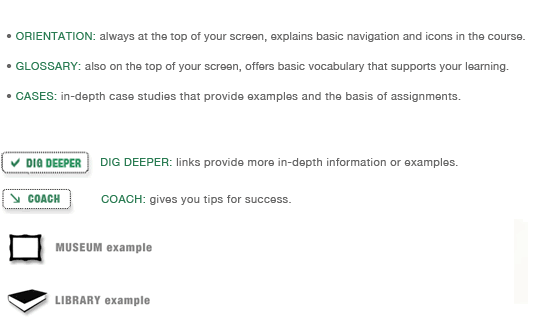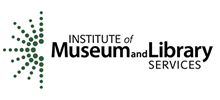Resources
Resources are available as you feel the need for them throughout the course.

Readings
Clegg & Associates, Inc. (2005). The logic model game. Retrieved August 8, 2005, from http://www.cleggassociates.com/html/modules.php?name=Content&pa=showpage&pid=23&cid=5
Clegg & Associates, Inc. incorporate outcomes-based evaluation in their strategic planning, evaluating, and facilitating for nonprofit and public sector organizations. This game is a tool to help build and design a logic model. It provides a concise overview of the logic model elements: resources, activities, outputs, outcomes, and goals. Some of the vocabulary is a little different from the Shaping Outcomes OBPE course, but the principles are the same even though it uses health services and environmental examples.
Diamond, Judy. (1999). Practical Evaluation Guide: Tools for Museums and Other Information Educational Settings. Walnut Creek, CA: Alta Mira Press.
This handbook provides an introductory guide to tools and approaches for assessing how programs and exhibits communicate their intended messages to museum audiences. It includes samples of strategies for collecting information on museum learning and describes how to construct and use them.
Florida Department of State, Division of Library and Information Services. (2000). Workbook: outcome measurement of library programs. Tallahassee, Fl.: FDS.
Chapters include Introduction and Overview; Organizational Readiness Survey; Preparing for Outcomes; Logic Model; and Data Collection Plan.
Ondaatje, E.H., Zakaras, L., Brooks, A. & McCarthy, K.F. (2004). Gifts of the muse: reframing the debate about the benefits of the arts. Santa Monica, CA: RAND Research in Arts.
RAND Corporation is a nonprofit research organization providing analysis and solutions for public and private sector organizations globally. The book provides a comprehensive view of how the arts create public and private benefits, highlights how the arts are instrumentally and intrinsically beneficial. This publication has been peer reviewed for research quality and objectivity.
Rubin, Rhea Joyce, Demonstrating Results: Using Outcome Measurement in Your Library. Chicago: ALA Editions, 2006.
Written by a Library consultant, this book uses familiar task breakdowns along with key terms in a step-by-step, service-oriented format so that readers can master the outcome measurement process as they learn to enhance library programs using evaluation techniques, use and customize the 14 step-by-step workforms to address unique needs, gather and interpret statistically accurate data to demonstrate outcomes, as well as measure, evaluate, and present outcomes to attract funding. Examples and two running case studies demonstrate the application of the principles, and a toolkit provides tips on creating evaluations, coding data, and selecting a sample. Has excellent bibliographies of both evaluation in general and of evaluative tools.
United Way of America. (1999, April). Achieving and measuring community outcomes: challenges, issues, some approaches. Retrieved August 8, 2005, from http://national.unitedway.org/outcomes/resources/measuring_outcomes.cfm
United Way is often regarded as a successful pioneer of outcomes-based evaluation in their programs. This 34-page document provides introductory information on developing a logic model, action plan, theories, strategies for successful program planning, and evaluation the organization has used.
Weil, Stephen, “Beyond Big & Awesome: Outcome-Based Evaluation.” Museum News Nov-Dec. 2003.
Discussion of outcome-based evaluation -- what museums can learn from visitors' experiences and the need for museums to develop credible systems of feedback.
Weil, Stephen and Peggy D. Rudd. (n.d.). Perspectives on outcome evaluation for libraries and museums, [webpage of Institute of Museum and Library Services]. Retrieved August 18, 2005, from http://www.imls.gov/pdf/pubobe.pdf
This Institute of Museum and Library Services-published booklet is recommended to Outcomes Based Evaluation workshop participants. It contains the articles “Transformed from a Cemetery of Bric-a-Brac” by Stephen Weil and “Documenting the Difference: Demonstrating the Value of Libraries through Outcome Measurement” by Peggy D. Rudd as well as a breadth of resources for further exploration. The booklet concisely articulates the value of OBPE for museum and library practitioners.
Zweizig, Douglas. "With our Eye on the User: Needed Research for Information and Referral in the Public Library." Drexel Library Quarterly 12(1976):48-58.
In his influential review of existing research on information seeking, Zweizig found that the patron's perspective was largely overshadowed by a library-centered focus.
Organizations
Institute of Museum and Library Services (IMLS)
http://www.imls.gov/index.stm
The Institute of Museum and Library Services is the primary source of federal support for the nation’s 122,000 libraries and 17,500 museums. Its mission is to grow and sustain a “Nation of Learners." The web site has lots of useful information about OBPE including an introduction to and resources for successful program evaluation and a project planning tutorial.
United Way of America: Outcome Measurement Resource Network
http://national.unitedway.org/outcomes/
The United Way has championed the adoption of outcome measurement by health and human service programs. The Resource Network offers information, downloadable documents, and links to resources related to the identification and measurement of program- and community-level outcomes.




